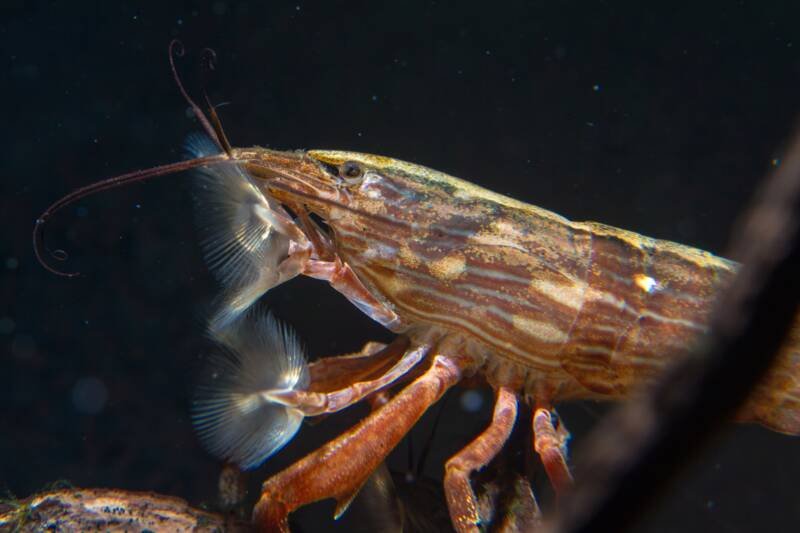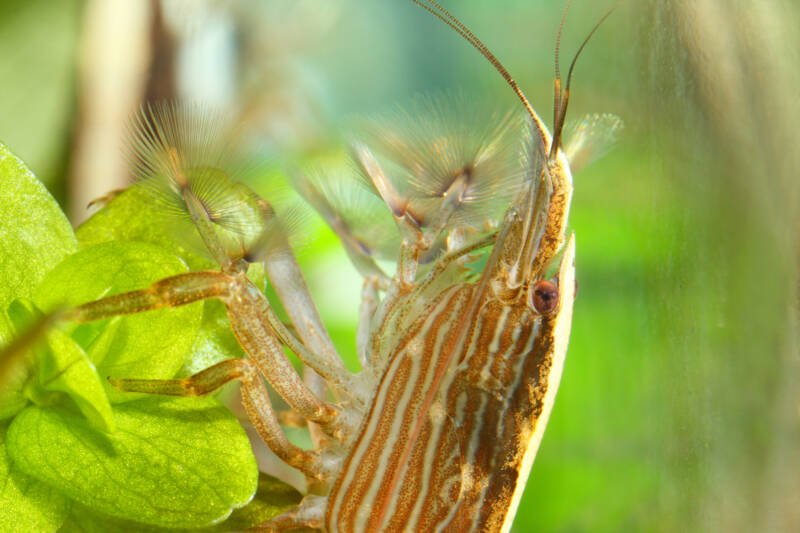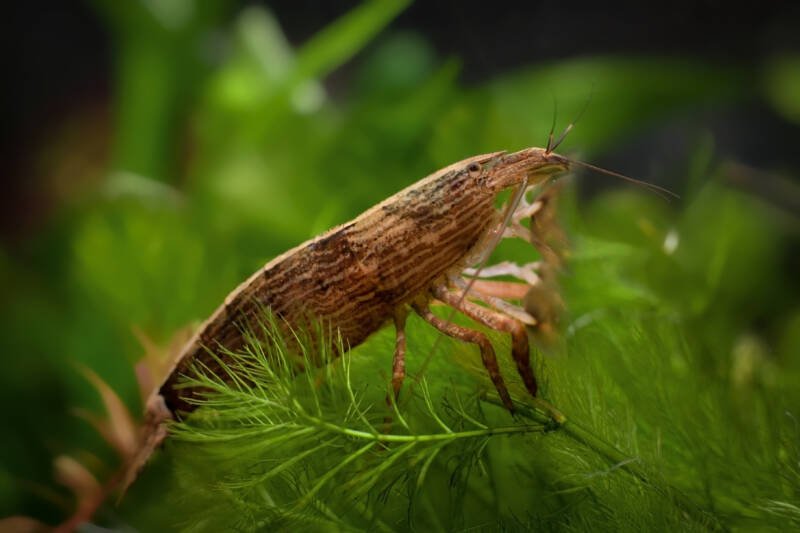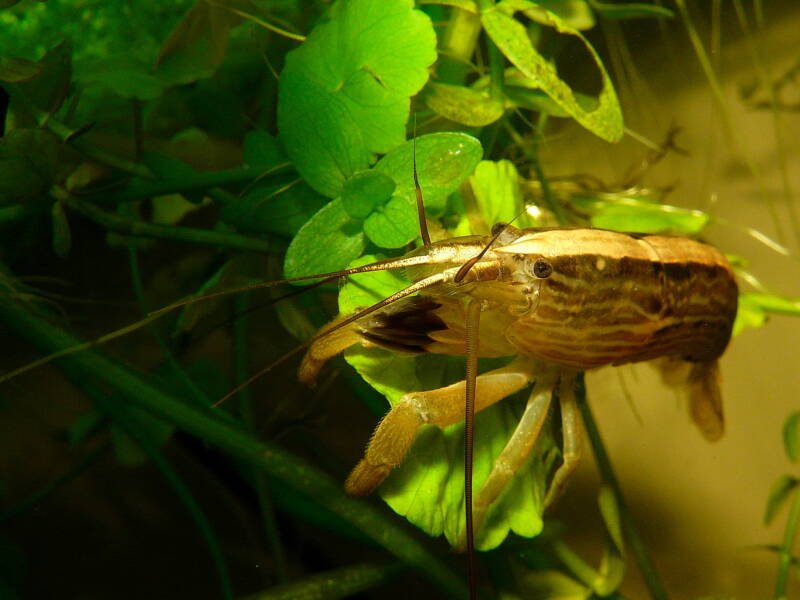Have you ever seen a bamboo shrimp? These stunning creatures are among the most exquisite shrimp species available in the aquarium trade.

Bamboo shrimp are exceptional filter feeders, using their fan-like appendages to capture and sift through particles in the water for their next meal.
However, caring for bamboo shrimp can be challenging due to their delicate nature.
But the rewards are well worth the extra effort. Aquariums that house bamboo shrimp are lively and exciting to observe.
At a Glance
| Min tank size: | 20 gal (80 l) |
| Temp: | 68-85°F (20-29°C) |
| Lifespan: | 1-2 years |
| Size: | 2 inches (5 cm) |
| pH: | 7.0-7.5 |
| Hardness: | 0-10 dKH |
| Ammonia: | < 2 ppm |
| Nitrite: | 0 ppm |
| Nitrate: | 0 ppm |
In this article
Appearance, Size, and Lifespan

The bamboo shrimp has only one scientific name, Atyopsis moluccensis, but has quite a few common names. These include the wood shrimp, flower shrimp, fan shrimp, Singapore shrimp, and even more besides these.
Bamboo shrimp are generally red with brown undertones and a pronounced white stripe running down their back.
However, they often change colors depending on their surroundings, mood, and health.
When comfortable, their red coloration emerges. But in some cases, they instead turn a vibrant cerulean blue.
Their most distinct characteristic is the “fans” attached to their hands. These are what they use to filter through the water to find food.

When they stop waving their hands and instead bring the fans quickly to their mouths, then you know they’ve just caught a meal! It can be mesmerizing to watch these beauties feed.
They grow up to three inches long, making them one of the largest freshwater aquarium shrimp available in the trade.
Unfortunately, the beauty of the bamboo shrimp is brief. These shrimp only live one or two years, and often have an even shorter lifespan of just a few months.
They may live longer if an aquarist keeps their tank in pristine condition, but this is rare.
It’s not uncommon for bamboo shrimp to die within the first week or even month after being introduced to a new tank.
Behavior
Like many other shrimp varieties, the bamboo shrimp is very peaceful and not at all aggressive.
It is not territorial and gets along well with a variety of other species.
This includes other shrimp, fish, snails, and more. Bamboo shrimp often enjoy being around others of their kind.
They will often group during their daily activities, like feeding. While grouped, they show no signs of aggression or even irritation.
They are active shrimp and will generally move about the tank for the majority of the day.
Feeding is their main priority, so that’s what you’ll see them doing most often.
If a shrimp seems listless and doesn’t move much, this may actually be a sign of disease or illness.
Molting is another interesting behavior for shrimp owners to watch, although it will only happen roughly every other month.
The molting process will begin with a shrimp finding a hiding place. After one or two days of hiding, when the shrimp is sure it’s safe, it will molt and emerge from its old shell.
At this point, the shell can be removed or left for other tank inhabitants to eat.
Shrimp Tank Setup
Wood shrimp are native to Southeast Asia and could be found in Sri Lanka, some regions of Japan, India, on the Malay Peninsula (Singapore, Southern Thailand, Malaysia), and the Samoan Islands.
Their tank setup should mimic the warm and slow-flowing waters of their natural habitat.
The size of the aquarium for bamboo shrimp largely rests on their dietary needs. Because they’re filter feeders, they need tanks with large water volumes.
As a result, each bamboo shrimp needs a minimum of 20 gallons (80 l).
Keeping shrimp colonies or community tanks, therefore, requires an impressively-sized aquarium.
Also, due to their filter-feeding, long tanks rather than tall tanks are better for bamboo shrimp. It may take food a long time in tall tanks to get to bamboo shrimp due to the water depth.
Equipment

Due to their small size and delicate nature, shrimp can be easily damaged in the aquarium.
To avoid such accidents, some modifications and precautions may be necessary.
Using the right aquarium equipment can go a long way in keeping shrimp safe.
- Filtration: Make sure your filter doesn’t cause a strong current that could trap or displace shrimp. Similarly, make sure the shrimp won’t get sucked into the filter intake and/or outtake.
- Heating: Any shrimp tank will need a heater to recreate their native tropical habitat. However, make sure the heater doesn’t have any small spaces the shrimp would wedge themselves into.
- Current: Filter feeding shrimp needs lots of water movement to thrive, so wavemakers and other equipment that create a current are recommended if your filter isn’t strong enough to do so.
- Plants: Live plants are recommended for aquariums with bamboo shrimp. Shrimp use them as a food source and eat excess plant matter. They also use them as places to hide, sleep, and explore.
- Lighting: If you have live plants (which bamboo shrimp love!), make sure your lighting is plant-grade and strong. Shrimp tanks often have a variety of plants, so the lighting will need to support them.
- Substrate: Similar to lighting, your substrate will largely depend on the type of plants you have. Finer substrates are recommended, as these are easier for shrimp to walk across and move around.
- Décor: Natural décors, like rocks and driftwood, are just as appreciated as artificial ones, like caves and ornaments. Both types provide bamboo shrimp with places to protect themselves and rest.
It can be more difficult to keep shrimp alive because of the many inadvertent dangers they face from aquarium equipment.
However, with the right tools and tank setup, your bamboo shrimp will be able to delight you for months to come.
Water Parameters

These shrimp do better in aquariums that have already been cycled and which are well-established and stable.
Like other shrimp, they are more sensitive to water parameters and are usually the first affected by unbalanced or high chemicals.
- Temperature: Bamboo shrimp prefers tropical water in the range of 68 – 85° F, preferably in the upper half of that range.
- pH Range: A pH range of 7.0 – 7.5 is acceptable, although some aquarists have suggested that it can go a bit higher or lower without adverse effects.
- KH: A water hardness range of 0 – 10 dKH is acceptable, the one exception to their usual need for specific parameters
- Ammonia: Make sure to remove excess food and waste from the aquarium so that ammonia levels stay under 2 ppm.
- Nitrites: Weekly water changes of at least 25% will keep nitrite levels under 2 ppm, but hopefully at 0 ppm most of the time.
- Nitrates: Any nitrate level above 0 ppm can be harmful to fish and shrimp, so regular water testing and cleaning must be done.
Because of their sensitivity, chemical imbalances in the tank affect shrimp the most.
Aquarists should also be careful of medications and plant fertilizers, as those have chemicals in them that may also hurt shrimp. Copper specifically is fatal to shrimp.
Tank Mates
Like most other shrimp, bamboo shrimp are peaceful and not aggressive. They don’t have any features that could cause harm like sharp teeth or claws.
However, this also means they don’t have any way to defend themselves. Because of this, bamboo shrimp should be housed with peaceful fish that won’t attack them.
They should also be housed with fish that won’t snack on them. This is a common problem in community tanks.
Fish that bamboo shrimp do well with include:
- Small gouramis like the dwarf and opaline gourami
- Small tetra species like the neon and ember tetra
- Catfish like corydoras and otocinclus catfish
- Other shrimp, like Amano shrimp, ghost shrimp, and cherry shrimp
- Snails, such as Ramshorn snails and Malaysian trumpet snails
Avoid goldfish, oscars, cichlids, discus, arowanas, crayfish, and other aggressive or prone to eating small tank inhabitants fish.
Filter-Feeding and Diet
Bamboo shrimp are filter-feeders. This means that they eat the fine particles of food that float throughout the aquarium water.
Fish food, plant matter and debris, micro-algae, and other micro-organizations are present in established aquariums.
These are what bamboo shrimp feed on, and they can eat quite a bit despite their small size.
Water changes, moving plants around, cleaning the gravel, and replacing the filter will cause excessive water current and stir up the substrate. As a result, these are prime feeding times for bamboo shrimp.
You may see them gather around to eat during these periods.
It’s fascinating to watch them feast, but be careful not to hurt them while you continue working.
Because of their diet, bamboo shrimp are mostly self-sufficient and don’t require much supplemental feeding.
But if you’re worried, there are shrimp-specific foods available for purchase.
You can also alter other types of fish food. For example, you can grind algae wafers and add drops of aquarium water to turn it into a paste for your shrimp.
Common Health Issues

A healthy bamboo shrimp is an active bamboo shrimp. The one exception to this rule is when they’re preparing to molt. At this stage, they may hide for a few days as they go through this process.
However, there may be an underlying health concern if your shrimp remains listless and doesn’t molt after a few days.
Similarly, if your bamboo shrimp refuses to eat for more than two or three days, it may be time to seek help.
These shrimp are also easily susceptible to stress. Being transported from the store to the tank can be a hugely stressful event, and has led to many premature deaths.
Another common source of stress is fluctuating water parameters or unclean water.
Shrimp are especially sensitive, so aquarists must take care to keep the highest quality of water possible.
You should also keep an eye on their appetite after bringing them home from the store.
In store tanks, bamboo shrimp might not have received enough to eat. When you add them to your tank, make sure food is readily available.
And as mentioned earlier, chemicals often contained in plant fertilizers and medicines can be detrimental. Copper is fatal, but there are plenty of other chemicals that are also dangerous.
Because of this, live plants present both unique benefits and drawbacks.
They are necessary for shrimp to feed on, hide in, etc. However, they also often require fertilizer doses to stay alive.
Be especially careful with root tabs and other forms of substrate fertilizers designed to slow release over time. The chemicals in these can build up underneath the substrate and then be released suddenly if the substrate is disturbed.
Bamboo Shrimp in the Aquarium
Bamboo shrimp are fascinating for both experienced aquarists and new hobbyists.
Their mesmerizing filter-feeding provides endless entertainment, and their striking coloring only adds to the beautiful show.
They’re perfect for community aquariums and species-only tanks, making them a versatile option for all tank owners.
They may not be the centerpiece of an aquarium, but they certainly won’t be overlooked anytime soon!